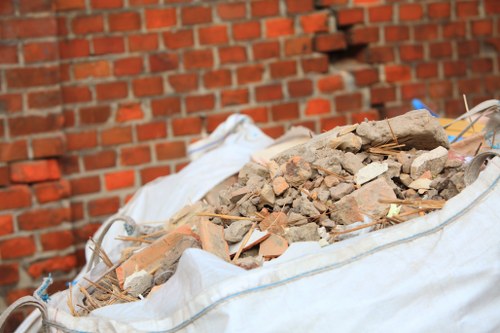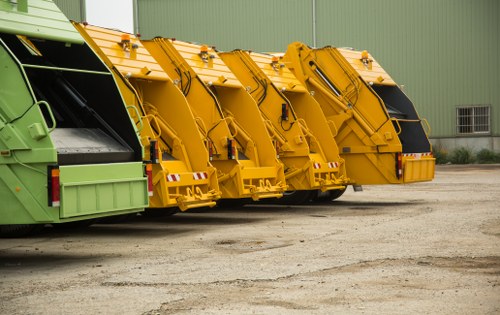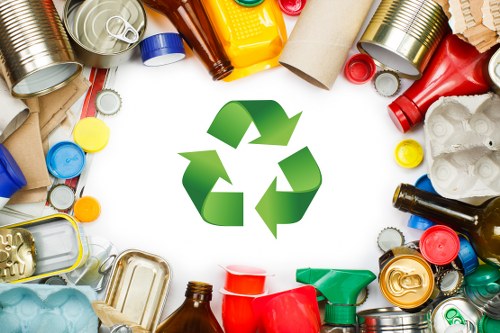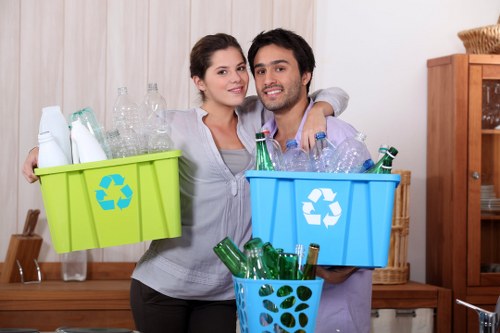Comprehensive Waste Clearance in Maryland

Managing waste effectively is crucial for maintaining the cleanliness and health of Maryland communities. Whether it's residential, commercial, or industrial waste, proper clearance ensures a safe and sustainable environment for everyone.
Waste clearance involves the collection, transportation, and disposal of various types of waste materials. In Maryland, several services specialize in this essential task, catering to the diverse needs of the population.
Understanding the different aspects of waste clearance can help individuals and businesses make informed decisions, promoting environmental responsibility and compliance with local regulations.
Why Waste Clearance is Essential

Waste clearance plays a vital role in public health and environmental protection. Accumulated waste can harbor harmful pathogens, attract pests, and contribute to pollution, affecting both urban and rural areas.
Effective waste management reduces greenhouse gas emissions, conserves natural resources, and minimizes the impact on ecosystems. By clearing waste regularly, communities can enhance their quality of life and ensure a cleaner future.
Moreover, proper waste clearance helps in recycling efforts, diverting materials from landfills and promoting the reuse of valuable resources. This not only benefits the environment but also supports the local economy.
Types of Waste Clearance Services

Maryland offers a variety of waste clearance services tailored to different needs. These services can be broadly categorized into:
- Residential Waste Clearance: Handling household garbage, bulky items, and recycling materials.
- Commercial Waste Clearance: Managing waste generated by businesses, including office waste, construction debris, and industrial byproducts.
- Hazardous Waste Clearance: Specialized handling and disposal of dangerous materials such as chemicals, electronics, and medical waste.
- Recycling Services: Collecting and processing recyclable materials to reduce landfill use and promote sustainability.
Selecting the right type of service ensures efficient waste management and compliance with local laws, minimizing potential environmental and health risks.
Choosing the Right Waste Clearance Provider

Choosing a reliable waste clearance provider in Maryland can be challenging, given the variety of options available. Here are some factors to consider:
- Licensing and Certification: Ensure the company is licensed and adheres to state and federal regulations.
- Experience: Look for providers with a proven track record and expertise in handling specific types of waste.
- Services Offered: Choose a company that offers the services you need, whether it's residential cleanup, commercial waste management, or hazardous material disposal.
- Environmental Practices: Opt for providers that prioritize recycling and environmentally friendly disposal methods.
- Customer Reviews: Check testimonials and reviews to gauge the company’s reliability and customer satisfaction.
By considering these factors, you can select a waste clearance provider that meets your needs and supports sustainable practices.
Benefits of Professional Waste Clearance

Hiring professional waste clearance services offers numerous benefits:
- Health and Safety: Professionals are trained to handle waste safely, reducing the risk of accidents and exposure to harmful materials.
- Efficiency: Experienced providers can clear waste quickly and effectively, minimizing disruption to your daily activities.
- Compliance: Professional services ensure that waste is disposed of in accordance with local and federal regulations, avoiding potential fines and penalties.
- Environmental Protection: Proper disposal and recycling efforts help protect the environment and promote sustainability.
- Cost-Effective: Efficient waste management can save money in the long run by preventing property damage and reducing the need for emergency cleanups.
These benefits highlight the importance of investing in professional waste clearance services for both individuals and businesses.
Waste Clearance Process in Maryland
The waste clearance process typically involves several key steps to ensure effective and compliant disposal:
- Assessment: Evaluating the type and volume of waste to determine the appropriate clearance method.
- Collection: Gathering the waste from the source, whether it's a residential property, commercial site, or industrial facility.
- Transportation: Moving the collected waste to designated disposal or recycling facilities.
- Disposal: Properly disposing of the waste in accordance with environmental regulations, including recycling or landfill use.
- Documentation: Maintaining records of waste management activities for compliance and reporting purposes.
Each step is crucial for ensuring that waste clearance is performed safely and responsibly, minimizing environmental impact and promoting public health.
Impact of Waste Clearance on Maryland Communities
Effective waste clearance has a profound impact on Maryland communities:
- Public Health: Reducing waste accumulation prevents the spread of diseases and improves overall community health.
- Environmental Sustainability: Proper waste management conserves resources, reduces pollution, and protects natural habitats.
- Aesthetic Appeal: Clean and waste-free environments enhance the beauty and livability of neighborhoods.
- Economic Growth: Efficient waste management supports local businesses and attracts new investments by maintaining a clean and sustainable environment.
- Community Well-Being: A clean environment fosters a sense of pride and responsibility among residents, promoting community engagement and cooperation.
These positive effects underscore the essential role of waste clearance in building healthy and thriving communities across Maryland.
Local Regulations and Compliance
Maryland has specific regulations governing waste clearance to ensure that waste is managed safely and responsibly:
- State Laws: Maryland state laws outline the requirements for waste disposal, recycling, and handling of hazardous materials.
- Local Ordinances: Individual counties and cities may have additional rules and guidelines for waste management, tailored to their unique needs and environments.
- Permits and Licensing: Waste clearance providers must obtain the necessary permits and licenses to operate legally within the state.
- Reporting and Documentation: Proper documentation of waste management activities is required for compliance and environmental monitoring.
- Penalties for Non-Compliance: Violations of waste management regulations can result in significant fines and legal consequences, emphasizing the importance of adhering to the laws.
Understanding and complying with these regulations is essential for both waste clearance providers and those who utilize their services, ensuring the protection of Maryland’s environment and public health.
Innovative Waste Clearance Solutions
Advancements in waste clearance technologies and methods are transforming the industry in Maryland:
- Automation and Robotics: Automated systems and robots are being used to sort and process waste more efficiently, reducing the need for manual labor and minimizing errors.
- Recycling Technologies: Innovative recycling techniques are increasing the range of materials that can be recycled, enhancing resource recovery and reducing landfill use.
- Biodegradable Materials: The development and use of biodegradable materials are decreasing the environmental impact of waste and promoting sustainability.
- Smart Waste Management: IoT and data analytics are improving waste collection schedules, optimizing routes, and enhancing overall efficiency.
- Energy Recovery: Waste-to-energy technologies are converting waste into usable energy, providing alternative power sources and reducing reliance on fossil fuels.
These innovative solutions are shaping the future of waste clearance in Maryland, making the process more efficient, sustainable, and environmentally friendly.
Community Involvement in Waste Clearance
Community participation is essential for the success of waste clearance initiatives:
- Education and Awareness: Informing residents about proper waste disposal practices and the importance of recycling fosters responsible behavior.
- Volunteering: Community clean-up events and volunteer programs engage residents in maintaining a clean environment.
- Collaboration with Local Organizations: Partnering with schools, businesses, and nonprofits can enhance waste clearance efforts and promote sustainability.
- Incentive Programs: Offering rewards for recycling and proper waste management encourages participation and compliance.
- Feedback and Improvement: Gathering input from the community helps waste clearance providers improve their services and address specific needs.
By fostering a collaborative approach, Maryland communities can achieve more effective and sustainable waste management outcomes.
Technological Advancements in Waste Clearance
Technology is revolutionizing the way waste is managed in Maryland:
- Smart Bins: Equipped with sensors, smart bins monitor waste levels and optimize collection schedules, enhancing efficiency.
- Data Analytics: Analyzing waste data helps identify trends, improve resource allocation, and develop better waste management strategies.
- Automated Sorting: Advanced sorting systems increase the accuracy and speed of recycling processes, reducing contamination and improving material quality.
- Mobile Applications: Apps provide residents with information on waste collection schedules, recycling guidelines, and service requests, improving communication and convenience.
- GPS Tracking: Tracking waste collection vehicles ensures timely pickups and helps manage fleet operations more effectively.
These technological advancements are making waste clearance more efficient, transparent, and responsive to the needs of Maryland residents and businesses.
Sustainable Practices in Waste Clearance
Sustainability is at the core of modern waste clearance strategies:
- Recycling and Reuse: Emphasizing the recycling of materials and the reuse of products reduces waste and conserves resources.
- Composting: Organic waste is converted into compost, enriching soil and reducing landfill contributions.
- Energy Efficiency: Waste clearance operations focus on reducing energy consumption and utilizing renewable energy sources.
- Minimal Landfill Use: Strategies to minimize landfill dependency include increasing recycling rates and developing alternative disposal methods.
- Green Packaging: Promoting the use of sustainable packaging materials reduces the overall waste footprint.
By adopting sustainable practices, Maryland's waste clearance efforts are contributing to environmental protection and the long-term well-being of the community.
Future of Waste Clearance in Maryland
The future of waste clearance in Maryland looks promising, with ongoing innovations and a strong focus on sustainability:
- Zero Waste Goals: Initiatives aiming for zero waste focus on eliminating waste wherever possible through reduction, reuse, and recycling.
- Circular Economy: Embracing a circular economy model ensures that products and materials are continuously reused, reducing the need for new resources.
- Advanced Recycling Technologies: Continued advancements in recycling technology will increase the range and efficiency of recyclable materials.
- Policy Enhancements: Strengthening waste management policies and regulations will support more effective and sustainable waste clearance practices.
- Community Engagement: Greater involvement from the community will drive demand for better waste management services and encourage responsible waste disposal habits.
These trends indicate a move towards more innovative, efficient, and environmentally conscious waste clearance systems, ensuring a cleaner and healthier Maryland for future generations.
Top Areas for Waste Clearance Services in Maryland
Maryland is home to several areas with high demands for waste clearance services. Here are the top regions and what makes them unique:
- Silver Spring: Located just north of Washington, D.C., Silver Spring is a bustling area with a mix of residential and commercial properties requiring efficient waste management.
- Baltimore: As one of Maryland's largest cities, Baltimore has diverse waste clearance needs, from urban waste to industrial byproducts.
- Frederick: This rapidly growing city balances historic preservation with modern waste management solutions, promoting sustainable practices.
- Columbia: Known for its planned communities, Columbia emphasizes eco-friendly waste clearance and recycling programs.
- Glen Burnie: With a mix of suburban and industrial zones, Glen Burnie requires versatile waste management services.
- Rockville: A hub for technology and innovation, Rockville seeks advanced waste clearance solutions to match its progressive environment.
- Gaithersburg: This diverse city benefits from comprehensive waste management services that cater to both residential and commercial sectors.
- Towson: Home to Towson University, this area requires specialized waste clearance for educational institutions and student housing.
- Bel Air: As a key community in Harford County, Bel Air focuses on sustainable waste management and community involvement.
- Hagerstown: With its strategic location, Hagerstown serves as a central point for waste clearance services in the western part of Maryland.
- Easton: Located on the Eastern Shore, Easton balances agricultural waste management with residential needs.
- Laurel: This city integrates efficient waste clearance practices to support its mixed-use developments and growing population.
- Greenbelt: Known for its green initiatives, Greenbelt prioritizes eco-friendly waste clearance and recycling efforts.
- Odenton: With significant commercial and industrial activity, Odenton requires robust waste management solutions.
- Takoma Park: This community emphasizes sustainable waste clearance and active participation in recycling programs.
These areas represent the diverse landscape of Maryland, each with unique waste clearance requirements and a commitment to maintaining a clean and sustainable environment.
Conclusion
Waste clearance is a critical component of maintaining the health, cleanliness, and sustainability of Maryland communities. By understanding the types of services available, choosing the right providers, and engaging in sustainable practices, residents and businesses can contribute to a cleaner and healthier environment.
Maryland’s commitment to innovative waste management solutions and community involvement sets a positive example for effective waste clearance. As technology advances and sustainable practices become more integrated, the future of waste management in Maryland looks promising and pivotal for environmental preservation.
Frequently Asked Questions
1. What types of waste can be cleared by professionals in Maryland?
Professionals can handle various types of waste, including residential trash, commercial waste, hazardous materials, construction debris, and recyclable materials.
2. How often should I schedule waste clearance services?
The frequency depends on the volume and type of waste generated. Residential clients typically schedule weekly or bi-weekly pickups, while businesses may require more frequent services.
3. Are there recycling options available through waste clearance services?
Yes, many waste clearance providers offer recycling services, helping to divert recyclable materials from landfills and promote sustainability.
4. How can I ensure that my waste is disposed of responsibly?
Choose licensed and reputable waste clearance providers who follow local regulations and prioritize environmentally friendly disposal methods.
5. What should I do with hazardous waste at home?
Hazardous waste should be handled by professionals. Contact your local waste clearance service to arrange for safe and compliant disposal.